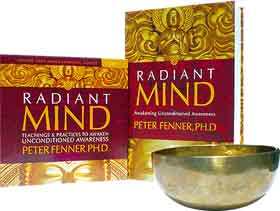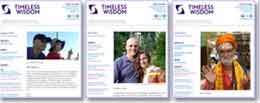Download a PDF of the 500 pages Nondual Training Manual table of content
Table of Content
Acknowledgements
Guidelines for this Manual
PART ONE: Distinctions and Practices of Nondual Transmission
1 • Introduction: the Radiant Mind model
- A contemporary and accessible presentation of timeless wisdom
- A contentless transmission
- The Radiant Mind approach
2 • Presencing unconditioned awareness
- Beginning a session
- Discovering your own process
- Distinguishing nondual awareness
- Is the nondual an experience, state or space?
- Entering a different paradigm
- The nondual isn’t a subtle affective experience or meditational state
- Purity
- Foundations, bridges and resting places
- Starting at the end: working at the result level
- Undoing the path
- We are talking about “This”!
- Paradox and nonduality
- Collapsing the distinction
- The progressive presencing of co-emergent wisdom
- The reliances
3 • Creating the space: setting the mood, pace and atmosphere
- An anti-frantic atmosphere
- Going nowhere, doing nothing
- Not knowing
- Spiritual transformation is different from spiritual knowledge
- Demonstrating not knowing
- The need to create meaning
- Nondual Transmission in one image
- In time and on the pleasure-pain continuum
- Working in the here and now
- Listening to the tensing: past, present and future
- Beyond pleasure and discomfort
- Positive experiences
- Bliss
- The healing power of sensate bliss
- Letting things be: noninterference
- Cultivating a homing instinct
- Not conditioning the future
- Not conditioning the next moment
- Preferring neither speech nor silence: giving equal value to both
- Natural contemplation: effortless meditation
- Attachment to suffering: not making problems out of problems
- Is that a problem?
- Re-labeling “this feels uncomfortable” as “this feels different”
- Not denying our conditioned existence
- Denial and being real
- Living without resistance
4 • Nondual relationship: the union of wisdom and intimacy
- Intimacy
- Nondual wisdom
- Pure listening
- Energetic resonance
- No separation: one consciousness
- Relating to people as streams of consciousness
- Listening to, and engaging with, non-verbal conversations
- Suspension
- Allowing silence to emerge in an uncontrived manner
- Playing at the edges of silence
- Adjusting to silence
- Communicating in deep silence
- Working creatively with silence
- Discerning different qualities of silence: sensing if people are in deep meditation or protecting their beliefs
- Reading the depth and stability of interiorized presence in people’s foreheads
- Serenity—thinning out our thoughts
- Nothing to think about
- Being with nothing
- Nothing is hidden: you don’t need to go looking
- Distinguishing between a report and a request
- When to use “I,” “you” and “we”
- The nondual use of “I” and “you”
- Distinction between being and having an identity
5 • Continuous presence: releasing glitches in the flow
- Creating glitches
- Working with your own identities
- Deconstructing yourself: working with your own conditioned identities that can arise in nondual facilitation
- Ability to experience the nondual in reactive situations
- Feeling irrelevant to the process at times
- Not getting lost in personal experience
- Complete in the unconditioned
- Ways to achieve completion
- Ways to reduce slippage
- Correcting the oscillation between polarized beliefs:
- gently moving people into “positionlessness” 137
- Mind empty: nothing to say
- Working in eternity
- Handling conversations that are easy to get caught up in
- Nondual inquiry as a form of spiritual bypass!
- This is intellectual and abstract!
- Is there love in unconditioned awareness?
- Radical intimacy
- Working with the question of love in the here and now
- How will this change me—will I be happier?
- Does nondual awareness influence the conditioned?
- What about choice?
- Illusion and reality
- I can’t see what’s really there!
- The creative function of ambiguity and the conversion of confusion into objectless awareness
- This is all unreal!
- What can I do when I lose nondual awareness?
- I don’t have the time
- How can I maintain this state?
- Integrating the nondual: How do I apply this in daily life?
- The best preparation for the future is always to rest in pure awareness
6 • Mastering ways to stabilize presence: some skillful means
- Observing fixations
- Spiritual fixations
- Fixated about fixations
- Lenses through which to observe fixations
- Bodily awareness
- Fixations do not require “fixing”
- There are no obstacles!
- Introducing the idea of constructions
- Recognizing the soft spot in a construction
- Thinking something is true doesn’t make it true
- Nondual inquiry: deconstructive conversations
- Feeling the difference between constructive and deconstructive conversations
- The unfindability of unfindability
- Nondual inquiry as a specialized conversation
- The impulse for inquiry
- Types of deconstructive conversations
- Shifting to a meta-position
- Natural koans
- “Who am I?”
- “What is this?”
- When and how to pose these questions
- Making the unconditioned into something
- Removing concepts: tracking and managing
- the gradient of the nonconceptual transmission
- Experiencing “nothing”
- Experientializing the space of nondual awareness
- Seeing through—thinking about nothing
- Speaking from the unconditioned
- Contentless conversations—talking about nothing
- Two types of nothing
- Declarations
- Interrupting
- Rejecting an interpretation
- Nuanced inductions
- Describing and revealing
- The four ways of talking about nondual awareness
- Coherence and discrepancy in the language used to describe the nondual
- Identifying three ways of talking about unconditioned awareness
- Checking questions
- Dancing in the paradoxes of nonduality
- Articulate contradictions
- Dance steps—moving out of the mind into nondual awareness
PART TWO: Resources 273
- Appendix 1: The lineage of this work
- Appendix 2: The Heart of Liberating Wisdom
- Appendix 3: Verses on the Realized Mind
- Appendix 4: The Natural Freedom of Being
- Appendix 5: Chandrakirti’s Deconstruction of the Self
Bibliography
References



